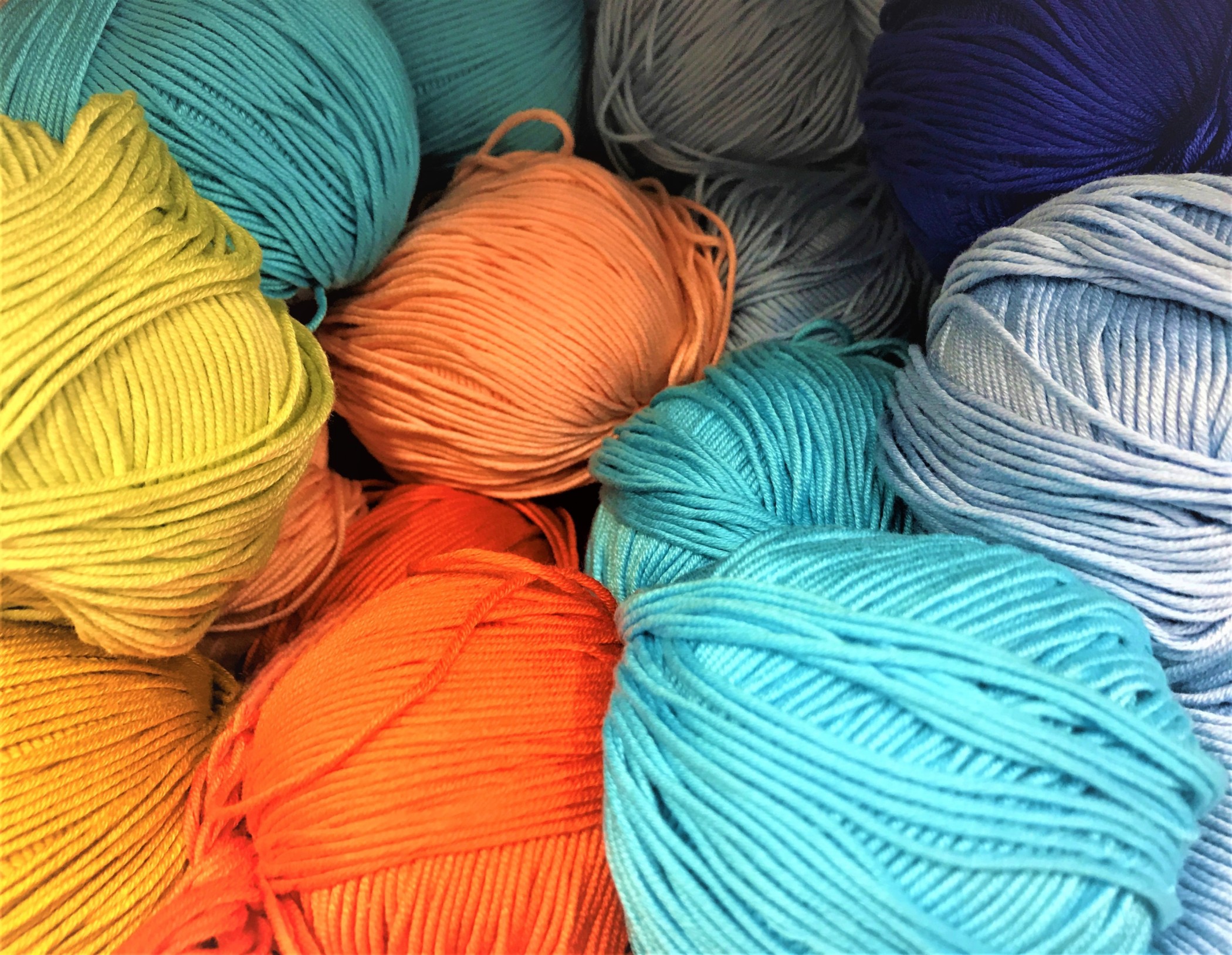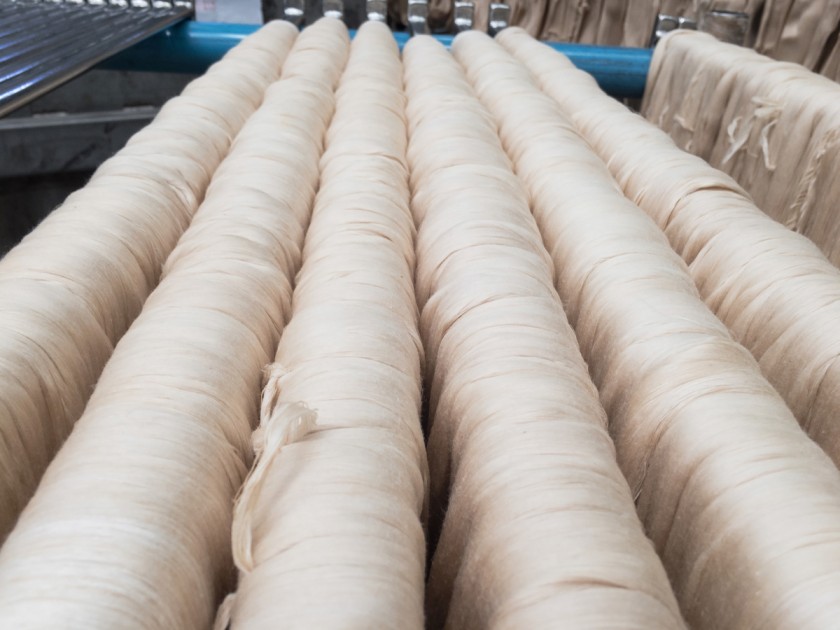Everything You Need To Know About Cotton Yarn Mercerization Procedure



In the wet processing technology, after bleaching and scouring processes, mercerization, a finishing treatment, occurs. By mercerizing the cotton yarn, its physical properties are modified to add unique properties. Mercerized cotton yarn has improved luster, strength and also has more affinity towards dye.
What is Mercerization?
Mercerization is a finishing treatment where the cotton yarn is treated with a strongly alkaline solution of Caustic Soda (Sodium Hydroxide), under appropriate tension and ambient temperature, to impart qualities such as improved luster, dye uptake, strength, etc. During the process, the physical structure of the fiber goes through several changes, which also result in a change in the mechanical properties of the fiber. In other words, mercerized cellulose is a hydrated form of cellulose. It is a product that is identical to its original condition but differs in physical properties in chemical terms. The process has been in use for some time and is noticing a surge in its application.
Basic Purpose Of The Process Is To:
- Improve luster
- Improve strength
- Improve moisture regain and dye uptake
- Improve reaction to a variety of chemicals
- Improve stability
Mechanism
Cells of the fiber are different in structure, like triangular, hexagonal, zigzag, etc. When the light falls on the cells, their structure is responsible for the reflectance. The reflection can be either regular or irregular, but it influences the luster of a fabric. When the process of mercerization occurs, the bean-shaped kidney cells of cotton go through swelling in the presence of a concentrated caustic soda solution. Due to the swelling, its cells become oval. This modified structure of cells reflects the light evenly and constantly, giving the yarn a ‘silk-like lustrous appearance and a softer feel. In other words, the luster of a fiber is the result of regular reflection of the light incident on the fiber's surface as it depends on the fiber's cross-section.
Also, when cotton is mercerized, along with luster, its tensile strength increases by 10-50%. The strength depends on factors, temperature, the concentration of caustic soda, construction of the yarn, and so on. If the temperature is low, the tensile strength will be more. If the alkali concentration is increased to 520 Tw, the strength will go up gradually, but if it is increased more, the strength will be significantly reduced. In the case of a staple yarn, the greater the yarn twist, the greater will be the strength.
Once added to the Caustic soda solution, the fibers of cotton shrink and become round. The lumen of the fiber becomes small, and the cell wall becomes greater; this improves the strength of the fiber by 20-30%. Generally, low twisted yarns are suitable for the process of mercerization. Mercerized cotton fabric, as compared to bleached fabric, is ideal for printing and dyeing as the ability to take up dyes increases.
At the Fiber level, the cross-sectional structure changes from bean-shaped to a round structure and goes through longitudinal shrinkage. At the Molecular Level, they undergo a hydrogen bond readjustment, changes in orientation of molecule chains in the amorphous region in the direction of fiber length. At the same time, it supports chemical changes such as an increase in the rate of hydrolysis and oxidation reaction, the liberation of heat during the process, and an increase in alkali and iodine absorption.
Advantages of Mercerization
During Mercerizing the cotton fabric, the cotton fibers go through different changes. Some of the most significant changes which improve the quality are:
- Shrinkage in the area of the cotton fabric.
- Increase in the tensile strength of the fabric.
- Improvement in the luster of the fabric.
- Improved Hygroscopic property.
- Increase in the capability of taking up dyes.
- Gives a soft touch to the fabric.
- Better covering of mossy cotton.
Types of Mercerization
Hot Mercerization
Due to extensive and rapid swelling of cotton fibers on treatment with an alkaline solution, the structure is compacted at the surface, and sodium hydroxide solution can’t be penetrated further. This results in non-uniform mercerization. If mercerizing occurs at an elevated temperature, it lowers the level of swelling in the cell wall and aids even penetration of the solution into the yarn. During hot mercerization, the fabric is treated with a caustic soda solution at 100℃, followed by controlled hot stretching of the material, cooling, and traditional tension controlled wash and rinsing at the end.
Advantages of Hot Mercerization
- Uniform degree of mercerization
- Uniform coloration
- Improved tensile strength, luster, easy-care properties, dimensional stability.
Slack/Cold Mercerization
In this kind of mercerization, the focus is on good moisture absorption and good dye uptake of the fabric. Strength and luster are not necessarily required. It is done for the products such as bandages, skirts, casual wear, boat covers, etc. During the process, cotton fabric is allowed to go through shrinkage without tension in caustic soda solution with 25-30% of concentration at 30℃ for around 60 seconds. The fibers shrink by 15-19%, along with lateral swelling of yarn fibers.
Factors leading To Mercerization
Twaddle (Unit of concentration Of NaOH)
Improvement in luster is achieved when the concentration of caustic soda is increased to more than 560 Tw. If it is decreased to less than 480 Tw, the luster quality would be affected.
Temperature
A high degree of luster is achieved at a temperature of 18-20℃. With an increase in temperature, the quality of the luster is impacted, but if the temperature is lowered, no further improvement in luster is seen.
Tension
For better luster, the fabric is stretched to the original dimension (both warp and weft). If the material is left to shrink during the process, the luster quality would be adversely impacted. In contrast, if the material is stretched more, there is no further improvement in luster.
Time
The average time for the process is 30-60 seconds. If the time duration increases, no improvement in the quality is seen. But if the time is decreased to less than 30 seconds, improved quality of mercerization will be achieved.
Steps Of A Typical Mercerizing Cycle And Their Significance

- Loading the material in a rest position on the rollers.
- Lowering of the rollers
- Movement of Caustic tray
- Pre-Tensioning: This first step runs to distribute the greige yarn hanks uniformly on the rollers along with the reversal of direction of the movement of rollers without entanglement. During this step, the material should become entirely wet.
- Free shrinkage: This is when the actual alkaline solution treatment takes place. Here, yarn is allowed to shrink freely without tension and is run for a sufficient amount of time in the relaxed state to react completely with the alkali. The higher the shrinkage level, the better the mercerizing quality will be.
- Lye tensioning: The yarn is stretched back to its original state in this step.
- Squeezing: To remove the excess alkaline solution from the material. Like this, the material is washed correctly and quickly to reduce the alkaline content. This ensures minimum wastage of alkaline solution during the wash.
- Movement of washing tray
- First wash and Tensioning: In this step, stretch is applied to the material and is washed with the stretching beyond its original state to produce a better luster. The amount of stretch depends on the quality of luster required, along with the quality of yarn. The temperature is kept near boiling to make the step efficient and short. The washing time is adjusted to reach below 10% caustic content residue.
- Second wash
- Third wash
- Final wash: The last caustic residue should preferably be less than 10%. If it is more than that, it will be enough to carry out further mercerizing effects and shrink the material again. During mercerized yarn or fabric storage, the water will evaporate from the exposed areas and get concentrated, leading to mercerizing effect. This will result in patchy dyeing. After the final wash, the residue of caustic content should be less than 3%; if it is more than that, the wash is not done effectively.
- Squeezing of the material
- Lifting of the rollers
- Unloading the hanks of the machine
This process was patented in 1850 by English calico John Mercer, and that’s how it got its name. It can be done in both yarn and fabric state. Woven fabrics can be mercerized in full width, whereas knit fabrics can be mercerized in full width and tubular form. Yarn mercerizing is expensive as compared to fabric mercerization. Mercerization is possible on greige fabrics, after desizing, after scouring, after bleaching, and after dyeing.
With the given information, we can conclude that mercerized cotton absorbs more dye and water than unmercerized cotton. The twist in the yarn will influence the water handling properties of that yarn, as it is proportionate to the yarn twist.



















